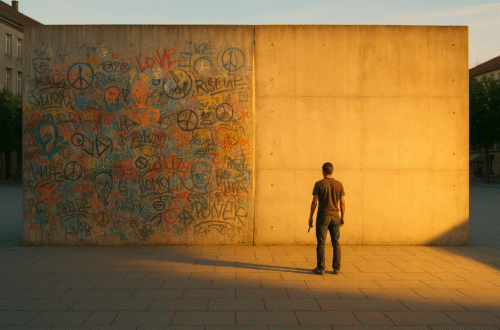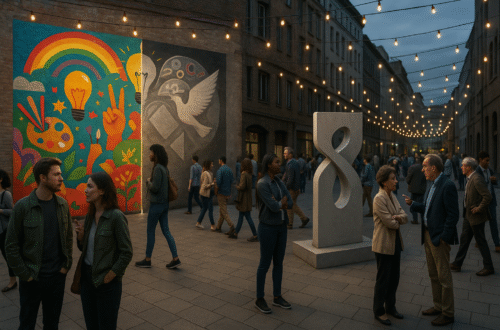A reflection on being lamplighters and keepers of grace
To inhabit this world with any depth of awareness is, I fear, to walk through a landscape of fracture. Heartbreak—whether personal or cultural—arrives not as an intruder, but as a companion. The unrest of nations, the sorrow of dying forests, the quiet grief that settles in the ribcage in the small hours of the night: these are not exceptions. They are the terrain.
And yet—beauty persists. Uninvited, unreasonably, gloriously so. It emerges where logic says it should not—like violets in the rubble or birdsong in a war zone. Its presence is not an argument against pain, but a quiet insistence that pain is not the final word.
To carry beauty through such a world is not to avert one’s gaze from sorrow. On the contrary, it requires us to look directly at it, with eyes unflinching and heart unarmoured. It is to live in the tension between despair and delight, and to refuse the easy comfort of either denial or despondency.
There is a peculiar courage in this. One might call it a cultivated tenderness—a kind of spiritual discipline that does not rush to resolve the ache, but instead makes space for it. This kind of seeing is neither passive nor naive. It is a moral choice. A way of saying: “Yes, this too is the world. And even here, something sacred glimmers.”
It has always been the artist’s way, and the mystic’s. And if I may be so bold, it is also the calling of every thoughtful soul: to find the thread of beauty, however fine, and follow it. To weave it into our days through whatever means we have—a letter written, a meal shared, a moment fully noticed.
Carrying beauty, then, is not solely an act of perception—it is an act of care. We become stewards of what is fragile and true. When the soul is heavy, this may look like walking slowly through the woods, or sitting in stillness with a cup of tea. When the world is unraveling, it may mean gathering others to remember what is good, to plant again where the soil was scorched, to sing even when our voices tremble.
This tending of beauty is a kind of resistance—not strident, but resolute. It is the quiet rebellion of choosing joy amidst ruin, kindness in the face of cruelty, presence in a world that trades in distraction. It is, in short, a declaration that life—despite everything—is still luminous, still worth the trouble.
And perhaps most profoundly, beauty restores our sense of kinship. Grief often isolates. But beauty draws us into connection—one to another, to the earth, and to the ineffable presence that undergirds all things. It reminds us that we are not alone. Not in our sorrow. Not in our wonder.
So how do we carry beauty?
We begin, quite simply, by noticing.
The glint of light on wet pavement.
The hush before a poem finds its final line.
The kindness of strangers. The steadiness of trees.
The way silence can feel like company, not absence.
We do not carry beauty because the world is whole.
We carry it because the world is not.
And in doing so, we become—however humbly—lamplighters.
Keepers of grace.
Reminders that even now, even here, joy still dares to bloom.






Reading this felt like a quiet revelation. The idea of beauty persisting amidst chaos is both comforting and challenging. It’s true—beauty doesn’t erase pain, but it does offer a kind of defiance against it. I wonder, though, how do we cultivate this “cultivated tenderness” in a world that often feels too loud, too fast, too broken? Is it possible to truly hold both despair and delight without one overshadowing the other? I’m struck by the thought that carrying beauty is an act of care—it feels like a responsibility, but also a gift. How do you find that thread of beauty in your own life, especially when everything feels heavy? And do you think this perspective is something we can teach, or is it something we must each discover for ourselves?
Thank you for your beautiful reflection. Your words land with the same quiet reverence that inspired the piece itself.
Yes—beauty as defiance. That’s precisely it. Not the aggressive kind, but something subtler, more enduring. A kind of soft-spoken rebellion against despair. And you ask the exact questions that matter most.
How do we cultivate “cultivated tenderness” in a world that is too loud, too fast, too broken?
Ah, isn’t that the crux of it? Cultivated tenderness begins, I think, in choosing slowness where speed is expected. Not in great, sweeping gestures—but in the gentle discipline of pausing. Of noticing. It begins by reclaiming the micro-moments: the warmth of tea in a chipped mug, the hush between two lines of music, the flicker of compassion in a stranger’s glance.
We cultivate it not by avoiding the noise and sorrow of the world, but by daring to remain soft within it.
Is it possible to truly hold both despair and delight without one eclipsing the other?
It is possible, though not always evenly. Think of it like walking with two companions—one joyful, one sorrowful—neither demanding dominance, only presence. The heart is vast enough, I believe, to make space for both. Sometimes delight speaks louder; sometimes despair. The wisdom lies in letting them speak in turn, and not mistaking either for the whole story.
As for how I find that thread of beauty when life feels heavy…
I return to the things that do not demand anything of me, yet offer everything: the trees, the sea, the wind across old stone. I read poetry—not to escape, but to remember. I let silence speak. I light candles even when I don’t feel luminous. And I try, imperfectly, to extend kindness—not grand, operatic kindness, but the sort that simply listens without rushing to fix.
Sometimes, I confess, I can’t find beauty at all. But I trust—because I’ve seen it before—that it will return. It always does. Often in unexpected places.
And your final question—can this way of seeing be taught, or must it be discovered?
Both, I’d say.
We can create conditions for it. We can model it, speak of it, make space for it in our homes and communities. But the actual seeing—ah, that must be discovered. It comes when one is ready to see. Like a wild bird, it won’t come if summoned too harshly. But if you wait quietly… it just might land beside you.
Thank you again for reading so deeply. Yours is the kind of response that tells me beauty is indeed still at work in the world.